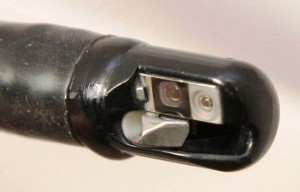 December 21, 2016 — Gastroscopes have now been linked to “superbug” infections, too, my research has found. This newly recognized risk has not been previously publicized.
December 21, 2016 — Gastroscopes have now been linked to “superbug” infections, too, my research has found. This newly recognized risk has not been previously publicized.
The University of Pittsburgh Medical Center (“UPMC”) identified six patients in January who were infected (or colonized) with carbapenem-resistant Klebsiella pneumoniae, according to an abstract presented in October at an infectious disease conference.
All six patients who received medical care in the hospital’s surgical intensive care unit (“SICU”) were “exposed” to the same gastroscope. (The abstract uses the word “exposed” presumably to refer to this gastroscope being used to perform endoscopy on each of these six patients.)
Parr et al. (2016), the abstract’s authors, wrote that they suspected that the gastroscope became contaminated with the cluster’s superbug and then transmitted it to each of these six patients.
In general, antibiotic-resistant bacterial infections linked to gastrointestinal (GI) endoscopes — at least those that have been the focus of recent federal alerts, news reports, and congressional reports — have been limited almost exclusively to duodenoscopes.
Carbapenem-resistant K. pneumoniae, or CRKP, is an emerging healthcare-associated pathogen — and a prominent type of superbug called carbapenem-resistant Enterobacteriaceae, or CRE.
UPMC’s abstract does not disclose the clinical outcome of these six patients and whether any expired. The mortality rate of patients infected with CRKP or a related CRE can be as high as 50%.
Nor does the abstract identify the brand and model of the implicated gastroscope. However, I identified six regulatory reports filed three weeks ago by Olympus, on November 30th, that appear to be the gastroscope manufacturer’s response to UPMC’s cluster.
Olympus (Center Valley, PA) manufactures the majority of GI endoscopes used in the U.S., with the remaining market shared by Pentax Medical (Montvale, NJ) and FujiFilm Endoscopy (Wayne, NJ).
These six Olympus regulatory reports (one filed presumably for each of the SICU cluster’s patients) name the model as the Olympus GIF-H180 gastroscope. And, it appears from these reports that Olympus first learned about UPMC’s January cluster only a few weeks earlier, on November 1st.
UPMC’s abstract, which is one of the first case reports to associate a gastroscope with a CRE cluster, infection or outbreak, has not been previously publicized (to the best of my knowledge). I identified this abstract while performing a detailed search of the literature and the FDA’s medical device reporting database.
Four years ago, in 2012, UPMC traced another cluster of the same bacteria type — carbapenem-resistant K. pneumonia — to contaminated duodenoscopes. (UPMC’s abstract presented in October does not reveal whether this 2016 Klebsiella strain was genetically related to the 2012 cluster’s bacteria.)
(Article continued below)
Confidential Case Reviews: Click here to read about Dr. Muscarella’s quality and safety services designed to assist manufacturers, hospitals and consumers reduce the risk of healthcare-associated infections, including mycobacterial outbreaks linked to contaminated heater-cooler devices.
(Continued from above)
Newly recognized risk
UPMC’s abstract may be the first case study to describe the newly recognized risk of gastroscopes transmitting CRE, but it is not the only report.
I searched the FDA’s medical device database and identified a regulatory report filed with the FDA in March documenting the contamination of four FujiFilm EG-450WR5 gastroscopes with CRE. According to its filed report, this manufacturer is unaware of any patient infections associated with this incident.
Similarly, I identified a regulatory report filed with the FDA last May linking a Pentax EG-2990I gastroscope to a CRE infection, although the patient also underwent ERCP using a duodenoscope, and the specific cause of the CRE infection is unclear.
 Duodenoscopes, like gastroscopes, are a type of endoscope used to treat disorders of the upper GI tract. Colonoscopes, which are also a type of GI endoscope, are used exclusively in the lower GI tract, primarily to examine and treat diseases of the colon.
Duodenoscopes, like gastroscopes, are a type of endoscope used to treat disorders of the upper GI tract. Colonoscopes, which are also a type of GI endoscope, are used exclusively in the lower GI tract, primarily to examine and treat diseases of the colon.
Other than the implicated gastroscope, Parr et al. (2016) did not suspect another environmental source or device to have played in role in the superbug’s transmission in UPMC’s SICU.
Source of the cluster: A CRKP carrier?
During its investigation of the cause of this cluster discovered last January, UPMC determined that in December 2015 a known carrier of the CRKP superbug was “exposed” to the same gastroscope subsequently used to treat the other six patients who tested positive for the bacteria.
UPMC determined that this carrier’s CRKP strain was related to the superbug isolated from each of the other six patients.
Parr et al. (2016) suggest that the gastroscope became contaminated with the bacteria in December when used to treat this CRKP carrier, remained contaminated with the superbug despite being cleaned and disinfected, and then subsequently transmitted the resistant bacteria to the SICU’s six patients.
UPMC identified a seventh SICU patient who also tested positive for the cluster’s CRKP, but who, unlike the SICU’s other six patients, had not been exposed to the suspect gastroscope — a finding that caused Parr et al. (2016) to suspect patient-to-patient transmission of the bacteria in the SICU unrelated to the gastroscope.
UPMC reported that the suspect gastroscope’s endoscope reprocessing practices were reviewed, but no lapses were identified. The gastroscope was likely disinfected using an automated endoscope reprocessor, or “AER,” although this is not discussed in the abstract.
For its part, Olympus reported in the regulatory reports it filed with the FDA that, “improper maintenance of the device cannot be ruled out as a contributory factor to the reported events.”
Suspect gastroscope tested, visually examined
Once the cluster was identified, UPMC removed the suspect gastroscope from use and tested it for CRKP contamination using two microbiologic sampling techniques. Endoscope sampling is routinely performed during an outbreak investigation to assess whether the instrument’s channels might be contaminated with bacteria.
These sampling technique can be unreliable, however. As many other studies have found, endoscope sampling lacks proper validation and can erroneously suggest that an endoscope contaminated with an outbreak’s bacteria is “sterile.”
In addition to culturing the gastroscope, Parr et al. (2016) reported that it used a borescope to visually inspect the device’s “lumen” (most likely, the suction channel) for defects and bacterial contamination.
(Article continued below)
Confidential Medical Device Reviews: Looking to identify the next medical device to be linked to bacterial outbreaks or a related adverse event? Click here to read about Dr. Muscarella’s research and review services designed to assist manufacturers, hospitals and consumers reduce the risk of medical errors and healthcare-associated infections, including mycobacterial outbreaks linked to contaminated heater-cooler devices.
(Continued from above)
A borescope is a small, thin flexible endoscope (with a camera) that has many non-medical applications, although it can be used to examine the inside of a GI endoscope’s otherwise visually inaccessible suction channel.
Borecopes have also been used during other outbreak investigations to inspect the internal, inaccessible surfaces of arthroscopic shaver hand-pieces for bacterial contamination.
Negative cultures mean exactly … what?
UPMC’s two sampling techniques yielded “negative” — or, “no bacterial growth” — results from the suspect gastroscope.
At odds with these findings, however, UPMC’s more reliable visual inspection of the gastroscope’s lumen using the borescope revealed “several deep scratches and luminal debris.”
Based in part of this finding, UPMC concluded that the suspect gastroscope’s channel became contaminated (possibly by the CRKP-carrier who was treated in December), was not adequately reprocessed, and then likely transmitted the retained bacteria to the SICU’s six patients.
In support of the conclusion, no additional CRKP cases were identified once UPMC replaced the gastroscope’s channel before returning the device for further use.
Understanding that endoscope culturing can yield false results, Parr et al. (2016) wrote in the abstract that failing to recover bacteria from a sampled endoscope “should not preclude a scope from suspicion.”
Based further on their findings, these authors most notably concluded that gastroscopes and other types of endoscopes less complex than duodenoscope “may fail high-level disinfection and cause infections.”
(Article continued below)
Updated CRE guidance — I provide updated guidance for the prevention of superbug infections following ERCP in my sponsored article, “Updated Guidance for the Prevention of Transmission of ‘CRE’ and other related ‘Superbugs’ during Gastrointestinal Endoscopy.” This article provides important recommendations to mitigate the risk of infection during ERCP (and other flexible endoscopic procedures).
(Article continued from above)
Gastroscopes, duodenoscopes, and the forceps elevator mechanism
Gastroscopes are used to perform esophagogastroduodenoscopy, or “EGD,” a procedure used to examine and treat diseases of the esophagus, stomach and small bowel.
Duodenoscopes are used to perform endoscopic retrograde cholangiopancreatography, or “ERCP.” These more complex endoscopes are much more versatile (and difficult to clean) than gastroscopes, use x-ray imaging, and are indicated for the removal of gallbladder stones, insertion of stents, and relief of obstructions of the bile ducts, among other treatments.
ERCP is performed more than 500,000 times a year in the U.S. EGD, in contrast, is performed millions of times a year in the U.S.

Gastroscopes are less complex in design and do not feature a forceps elevator mechanism — a component experts say is critical to performing ERCP using a duodenoscope. According to the FDA, this forceps mechanism is difficult to clean and may remain contaminated with bacteria despite being cleaned according to the manufacturer’s instructions.
Reports have linked contamination of this mechanism to several CRE outbreaks since 2012.
Notably, I identified a regulatory report filed in June describing a patient who became infected with a resistant bacteria after undergoing both ERCP and EGD using the same duodenoscope. Use of a duodenoscope to perform EGD may increase the risk of infection following EGD.
Bronchoscope infections — The following sponsored webinar I co-directed to prevent infectious during bronchoscopy was recently published: “Webinar: Infection Prevention During Bronchoscopy.” Also download: “Whose Instructions Should You Follow? A guide for resolving inconsistencies in the reprocessing instructions of bronchoscopes and automated endoscope reprocessors.“
Automated endoscope reprocessors, or AERs
A majority of U.S. hospitals used automated endoscope reprocessors, AERs, to reprocess GI endoscopes, including gastroscopes. AERs reportedly reprocess more than 90% of duodenoscopes in the U.S.
It is likely therefore that UPMC reprocessed its suspect gastroscope using an AER, although the mode is not disclosed in the abstract. (I cross-referenced the FDA’s medical device database and could not identify a report filed by an AER manufacturer that might correspond to UPMC’s CRKP cluster.)
Periodically, and as recently as last month, the FDA updates its webpage that provides information about AERs and their validation test results. On this webpage the FDA lists the AER models whose manufacturers have provided the Agency with data validating the model’s successful reprocessing of “sealed” and “open” duodenoscopes.
According to this webpage, the FDA considers duodenoscopes to be particularly challenging to reprocess.
But UPMC’s 2016 abstract somewhat belies the scope of this FDA webpage, which is limited only to duodenoscopes, concluding that even less complex, including gastroscopes, also “may fail high-level disinfection and cause infections.”
UPMC’s findings might argue for the FDA to expand the focus of its webpage to list the AER models that have been validated for the safe and effective reprocessing of, in addition to duodenoscopes, gastroscopes and (linear) echo-endoscopes.
The latter type of endoscope, which is used to perform endoscopic ultrasound (EUS), has been linked to possible CRE infection and, like the endoscopes, is equipped with a complex, difficult-to-clean forceps elevator mechanism.
Carbapenem resistance
Briefly, carbapenems are potent, broad-spectrum antibiotics often used in hospitals as a “last resort” for treating serious bacterial infections, including those caused by susceptible enterobacterial strains including K. pneumonia and E. coli.
The mortality rate of patients infected with CRE, including those infecting during GI endoscope (specifically, ERCP), can be as high as 50%.
Treatments for carbapenem-resistant bacterial infections may include (instead of, or in addition to, carbapenems) colistin or tigecycline, although both of these antibiotics can have serious side-effects. Colistin can be nephrotoxic, and tigecycline is indicated for use only “in situations when alternative treatments are not suitable.”
Conclusion and summary
My article herein is the first (that I am aware of) to discuss UPMC’s findings and abstract, and to publicize the newly recognized risk of gastroscopes infecting patients with CRE and other potentially deadly superbugs, despite being reprocessing according to their manufacturers’ instructions.
The FDA has warned about the risk of contaminated duodenoscopes and bronchoscopes infecting patients with antibiotic-resistant bacteria, but the Agency has not alerted the public about the potential for gastroscopes and other less complex endoscopes also to infect patients with a superbugs.
Other endoscope types that have been previously linked to infections caused by CRE or a related superbug include ureteroscopes.
Reports of colonoscopes transmitting CRE and their related superbugs have not been published to date. A regulatory report filed two years ago raises the possibility, however, reporting that five colonoscopes tested positive for several bacteria, including Klebsiella and E. coli, which could be CRE. Like UPMC’s abstract, this regulatory report states that a borescope was used to check the the colonoscope and “scrape marks were found in the biopsy channel.”

Another important finding, UPMC’s abstract advises that endoscope sampling, which is often used to test the endoscope for bacteria, are prone to false-negative results. These authors conclude that a “negative” test result “should not preclude a scope from suspicion.”
Parr et al.’s (2016) report additionally suggests that the FDA and CDC’s focus on duodenoscopes and the forceps elevator mechanism as the primary source of GI endoscope-related superbug infections should be expanded to include gastroscopes and other types of GI endoscopes less complex in design than duodenoscopes, which these authors conclude can also “fail high-level disinfection and cause infections” — a disquieting avowal.
This assessment also has certain public health implications for the content of the FDA’s webpage that provides information about AERs and their validation test results. Including on this webpage a list of the AER models that the FDA has validated for the safe and effective reprocessing of gastroscopes (and also liner echo-endoscopes) is recommended for safety and completeness.
Whether UPMC’s abstract linking a gastroscope to a cluster of CRE earlier this year was due, at least in part, to a poorly repaired or serviced endoscope is unclear. No matter, as I have previously published, the improper servicing, maintenance and/or repairing of flexible endoscopes may be a more significant risk factor for superbug infections than currently recognized.
Confidential Case Reviews: Click here to read about Dr. Muscarella’s quality and safety services designed to assist manufacturers, hospitals and consumers reduce the risk of medical errors and healthcare-associated infections, including mycobacterial outbreaks linked to contaminated heater-cooler devices.
Reference: Parr A, Querry A, Pasculle A, et al. Carbapenem-Resistant Klebsiella pneumoniae Cluster Associated With Gastroscope Exposure Among Surgical Intensive Care Unit Patients at University of Pittsburgh Medical Center. Presented; October 27, 2016. Open Forum Infect Dis (Fall 2016) 3 (suppl 1).
Article by: Lawrence F Muscarella, PhD. Posted Dec. 21, 2016; updated Dec. 28, 2016, Rev. A. LFM Healthcare Solutions, LLC Copyright 2016. LFM Healthcare Solutions, LLC. All rights reserved.
Click here for a list of Dr. Muscarella quality healthcare services designed to improve safety and reduce costs.
E: Larry@LFM-HCS.com. Twitter: @MuskiePhD